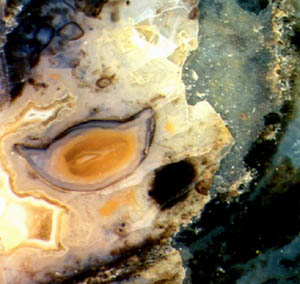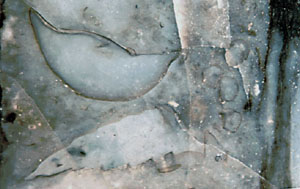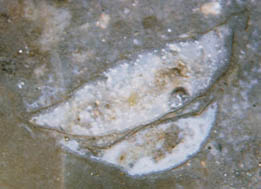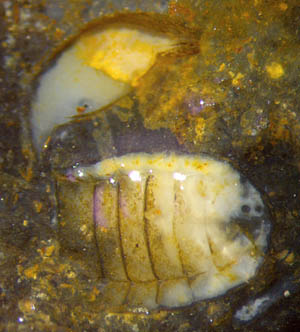Sociable trigonotarbids
The most sociable creature hitherto discovered in the Lower Devonian
Rhynie chert, the small crustacean Ebullitiocaris,
comes seldom alone
but seems to feel more comfortable in the crowd, grazing on alga layers
[1]. A smaller number of mites have been found huddled together within
an empty sporangium of Aglaophyton,
apparently feeding on the inner
wall [2]. Quite differently, trigonotarbids are assumed to prowl
alone
through thickets of the humble vegetation of that time [3] or to sit
in the empty sporangium watching the flock of mites as they
feed and grow unawares of the predator lurking behind them, and eat one
of them
every now and then [2]. Also there is evidence that they prefer
sheltered places for moulting as, for example, a hollow straw of
Aglaophyton
(Fig.1), where not rarely more than one moult is seen [4]. 
Fig.1: Moult parts of trigonotarbid, probably Palaeocharinus rhyniensis
within a hollow straw of Aglaophyton
(photograph by H. Sahm).
body cross-section, 2mm wide, and legs (above left). Part of
the inclined section of the poorly preserved tube, width about
5mm, is also seen.
In view of their solitary way of life, one would hardly expect to see
two
trigonotarbids incidentally at the same place in the chert. Hence, the
below pictures suggest that they came to the place on purpose, perhaps
for moulting or mating.


Figs. 2,3: Rare examples of trigonotarbid sections
arranged unexpectedly close to each other.
Apparently the aspect of the sections does not allow easy conclusions
to be drawn as to whether they represent the moult or the creature
entombed as a whole. The incomplete longitudinal body section with
separate leg sections in Fig.2 suggest that at least this one is a mere
moult.
Since the cut faces are usually more or less tilted and displaced with
respect to the symmetry plane of the body, the actual size and shape of
the cross-section and the longitudinal section cannot be derived from
sections like those in the above images. However, with the available
knowledge of trigonotarbids it can be stated that the upper section in
Fig.2 and the lower section in Fig.3 come close to cross-sections. (For
a whole trigonotarbid, bigger species than this one, cut well along the
symmetry plane, see Rhynie Chert News 9 .)
Although the upper section in Fig.3 is apparently more
tilted and thus
cannot immediately be compared with the section below, it seems to
belong to a specimen bigger than the one below. This could possibly be
an indication of sexual dimorphism.

Fig.4: Two trigonotarbids in Rhynie chert: top view (width
1.75mm) and
inclined cross-section (width 2mm, corrected for inclination) on the
raw surface of a chert layer fragment.
The trigonotarbid in Fig.4 (below) is not
a section. It is preserved in its true 3D-shape owing to the
crack which had separated it from the embedding rock, except for
the end on the right where part of the body got lost by spalling
fracture. The segmentation of the body is exceptionally clearly seen.
The above
images seem to indicate that if there are two trigontarbids in one
small sample, they are
more likely seen close together than far apart. It has to
be checked whether this is a rule or merely incidental. Hence, one
should look for more
paired trigonotarbid sections with the aim to find out some indication
concerning the behavior of these early terrestrial predators.
H.-J. Weiss
2011
complemented 2014
[1] L. Anderson et
al.: A new univalve crustacean from the
Early Devonian Rhynie chert hot-spring complex.
Trans.
Roy. Soc. Edinburgh, Earth Sciences 94(2004 for 2003), 355-369.
[2] H. Kerp,
H. Hass: De Onder-Devonische
Rhynie chert.
Grondboor & Hamer 58(2004), 33-50.
[3] http://www.abdn.ac.uk/rhynie/
[4] P.G. Kevan, W.G. Chaloner,
D.B.O. Savile: Interrelationships
of early terrestrial arthropods and plants.
Palaeontology 18
Part 2 (1975), 391-417, Plates 54-56.
 |
 |
42 |







